Many of us still think of it as the new kid on the block. But for anyone tracing the development of the performing arts in the Kansas City region, watching the growth of the performance series at Johnson County Community College has been a bit like seeing an awkward adolescent become a strong, capable member of the community. And in a region populated by powerful, venerated groups established generations ago, this was no mean feat.

The 2016 renovation of the 25-year-old Center included new paint and wall treatments, new carpet, new seat covers for Yardley Hall, updated technological capabilities, and a new Steinway Model D Concert Grand piano. / Photo by Susan McSpadden
The Midwest Trust Center (formerly known as The Carlsen Center) and the Series it houses are jointly celebrating a 30th anniversary this season, and one can hardly overestimate the impact that both have exerted on our region. That the MTC Series has continued to push forward, even as the Kauffman Center and other facilities have indelibly altered the local arts ecosystem, is a testament to the sheer will that was behind it from the beginning.
“The mission of Johnson County Community College is accessibility,” said Emily Behrmann, director of the Series since 2010. “The Center makes education more accessible, but it also … creates an open door for the community to interact with the campus.”
In the late 1980s, the JCCC Board of Trustees deliberately designed what was then called the Cultural Education Center to serve as a “front door” to the College’s 220-acre campus. “It was created to be a centerpiece,” said PGAV Architects’ Michael Schaadt, the lead architect for the project. “Not only for the College, but for the community.”
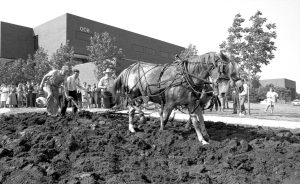
The dramatically staged groundbreaking of what is now Midwest Trust Center took place in September 1988, led by Dr. Bob Fry (center, with white dress-shirt and tie), chairman of the JCCC Board of Trustees, and Trustee Dr. Hugh Speer, right, who owned the team of plow horses that ‘broke the plain’ at College and Quivira.
The Center’s focus on the arts grew from a conscious desire to build a cultural hub in Overland Park. “This building was the first one that was oriented to face College Boulevard and Quivira Road, to face the community,” Emily said. “The students are priority number one here, obviously … but the College also wanted to make sure that the people who pay these property taxes, but who maybe don’t have a student here, or who never attend classes here themselves, can still find value, find something on the campus that they can feel a part of.”
Although more than half of the facility is devoted to classrooms, offices, and other student-centered spaces, at the heart of the Midwest Trust Center (renamed last year for the Overland Park-based financial group founded by Brad Bergman in 1993) are its state-of-the-art performance spaces, which since their introduction in 1990 have transformed concert-going in the region.
The 1,400-seat Yardley Hall was, at the time of its construction, the most comfortable, most fully modern performance space in the region, and the semi-circular, 400-seat Polsky Theatre has remained a favorite for more intimate shows. Wedged between them is a Recital Hall that can be set for an audience of 50 or so, which became the venue for the Ruel Joyce and Jazz Recital Series (both of which are still run by their founder, retired Dean of Arts & Humanities Doreen Maronde). A fourth venue, the Bodker Black Box Theatre, serves the JCCC Academic Theatre Department.

Emily Behrmann took the reins at the Midwest Trust Center in 2010-2011. / Photo by Roy Inman
The Series that quickly became MTC’s most notable public feature started small, initially under the direction of Jerry Snider, with an emphasis on local arts groups. “It has morphed from small-scale to a larger-scale, and has ebbed and flowed according to the budget,” said Jim Lane, dean of arts and design, humanities and social sciences. “But from day one it was absolutely planned as a series of presentations that would call for community support, in terms of ticket sales and season tickets.”
The Center’s initial season (1990-1991) featured concerts by the Kansas City Symphony, the Lyric Opera, the Kansas City Ballet, and the Kansas City Repertory Theatre, as well as lectures on the visual arts and current affairs. As the Center garnered more attention, international stars increasingly became the norm. In 2000 the College hired a nationally known arts presenter, Charles Rogers, to beef up the Series.
“Charles was brought here to take the programming to a much higher, more comprehensive level,” Emily said. “He really created a series of international reputation.” The intention was not to draw attention away from existing local arts groups, necessarily. “I don’t think the idea was to keep people from going Downtown,” Jim said. “It was just an alternative.”
Just as important, students of the College were always an important part of the mission. “Our goal was that they take advantage of these out-of-town acts,” Doreen said. “Anyone with a student ID can go for $5.”
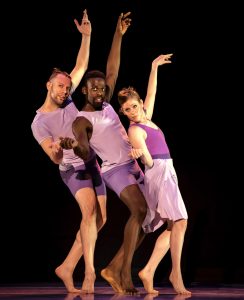
Charles Martin, Christopher Page-Sanders, and Felicia McBride performed in Darrell Moultrie’s ‘Vibes to be Caught,’ created for Owen/Cox Dance Group’s appearance in the 2018 New Dance Partners program. / Photo by Mike Strong.
In the early years, the Kansas City Ballet, the Lyric Opera, and the Kansas City Symphony presented “run-outs” that often formed a part of their own series. (The Symphony’s series ran all the way up to the opening of the Kauffman Center.) “It was primarily about having more performance opportunities,” said Kevin Aimey, general manager of the Ballet since the 1980s.
The Ballet also initiated its In the Wings program (a small-ensemble series now called New Moves) in the intimate Polsky Theatre. “It was a great place to present that kind of repertoire,” Kevin said.
Meanwhile, Charles was creating a series of international renown that some feared might convince suburbanites they didn’t need to go downtown. With the MTC bringing international orchestras, opera and dance companies, and star soloists to Johnson County, groups performing in aging downtown facilities had every reason to fear the Center, with its free parking, easy access, and gorgeous new halls.
But what happened surprised everyone. Audiences took the new MTC in stride but still found reasons to go Downtown. “People thought it was going to be either-or,” Emily said. “Either you’re going to go Downtown or you’re going to go here. … What’s happened is that it opened up possibilities: that maybe we can have opportunities available in more than one place, and that’s okay.”
Naturally, the opening of the sleek $400 million Kauffman Center in 2011 presented a new set of challenges for everyone. But audiences again surprised presenters, filling the new halls and the old ones as well.
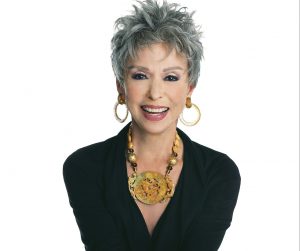
Rita Moreno, one of the greatest American performers of all time, belongs to the exclusive E.G.O.T. club, having won two Emmy Awards, a Grammy Award, an Oscar, and a Tony.
“I was probably as scared of the Kauffman Center as the downtown organizations were of this place when it opened,” Emily said with a laugh. “We all had conversations about how it’s going to be a game-changer, and it certainly has been. … But I want to carry forward on Charles’ reputation, in bringing world-class artists to this facility.”
While Charles’ version of the Series had emphasized high-end classical arts (with visits by such notable vocal groups as the Monteverdi Choir and the dance companies of Paul Taylor, Martha Graham, and Merce Cunningham), Emily has deftly pivoted the series to popular but still sophisticated presentations.
Among the highlights from her tenure so far have been Natalie Cole (“I loved watching her step out of her fuzzy slippers and into her Louboutin stilettos and stride out onstage to thunderous applause,” Emily said), Arlo Guthrie (“his die-hard fans always come out to see him, reminded of their youthful innocence in his presence”), Mexican vocalist Aida Cuevas (“hearing the entire audience sing along with her well-known ranchera hits was truly special”), or nonagenarian jazz legend Marilyn Maye (“she had the audience in the palm of her hand for this show and loved every moment of it”).
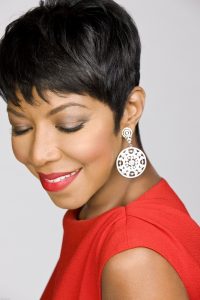
Natalie Cole’s 2014 appearance was one of the most dynamic that the Center has seen.
The astonishing list of other artists who have appeared over the decades includes Emilylou Harris, Peter and Paul, Maya Angelou, Lyle Lovett, Arturo Sandoval, Rita Moreno, Shirley MacLaine, James Galway, MOMIX, Blue Man Group, OK-Go, and Dr. John.
The Series has also developed local initiatives such as the New Dance Partners, in which four choreographers are commissioned to create new works each year for four local dance companies. “It’s a win-win for everybody,” said Jeffrey Bentley, Kansas City Ballet’s executive director. “The choreographers are able to able to get work, companies like ours are able to add repertory to our roster at a much-reduced expense, and audiences are introduced to new choreographic voices that they might not otherwise have been introduced to. And the field overall gets re-seeded every year.”
Though the College has subsequently built a number of other facilities that rival MTC’s prominence, including the Regnier Center, the new Student Center, and the Nerman Museum of Contemporary Art, the Center remains one of the most visible landmarks in the region, and the heart of the College’s performing arts programs.
“It’s the center of Overland Park,” said Jim Lane. “And because it’s up on one of the highest spots in Johnson County, in has become the apex: one the most prominent features of the County.”
Yet as proud as Johnson Countians are of the Center, they realize that they now form part of a larger, regional audience: a growing group of performing-arts enthusiasts who will pretty much go wherever interesting things are happening.

Aida Cuevas, Mexico’s most beloved female mariachi singer, who sings songs of empowerment and strength, performed at the Center with the all-female Mariachi Reyna de Los Angeles.
“We have an audience in Johnson County that likes to come here because it’s close to home … and because of the accessibility,” Emily said. “But I do think we’re a complement to what happens in other venues all over the city. It’s just one more opportunity for people to engage with the performing arts and find something they love and can relate to and that speaks to them. And keeping that all in one part of the city doesn’t make sense to me.”
—By Paul Horsley
Information on the MTC Series’ fall performances will be available in mid-June. Call 913-469-4445 or go to jccc.edu/midwest-trust-center.
For information about the upcoming online concert/culinary date-night Eat, Drink, Play: New Beginnings with Opus 76 Quartet, click here .
To reach Paul Horsley, performing arts editor; send an email to paul@kcindependent.com or find him on Facebook (paul.horsley.501) or Twitter (@phorsleycritic).
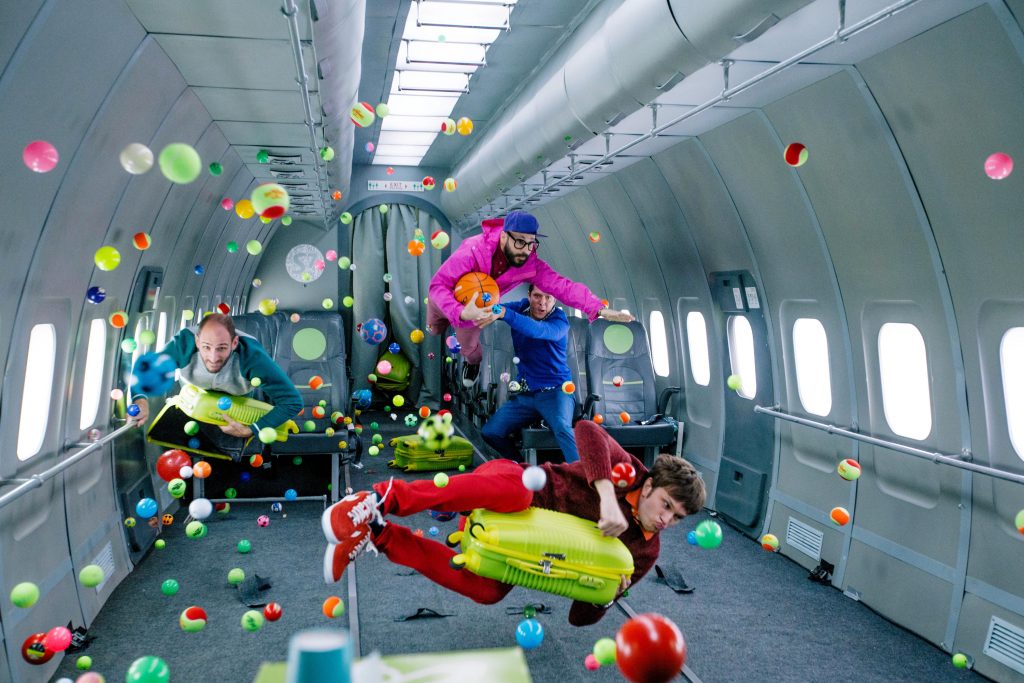
The innovative rock band OK-Go, which won the 2006 Grammy Award for Best Music Video, was shooting so much graffiti into Yardley Hall that ‘kids were making confetti-angels in the aisles,’ Emily said.